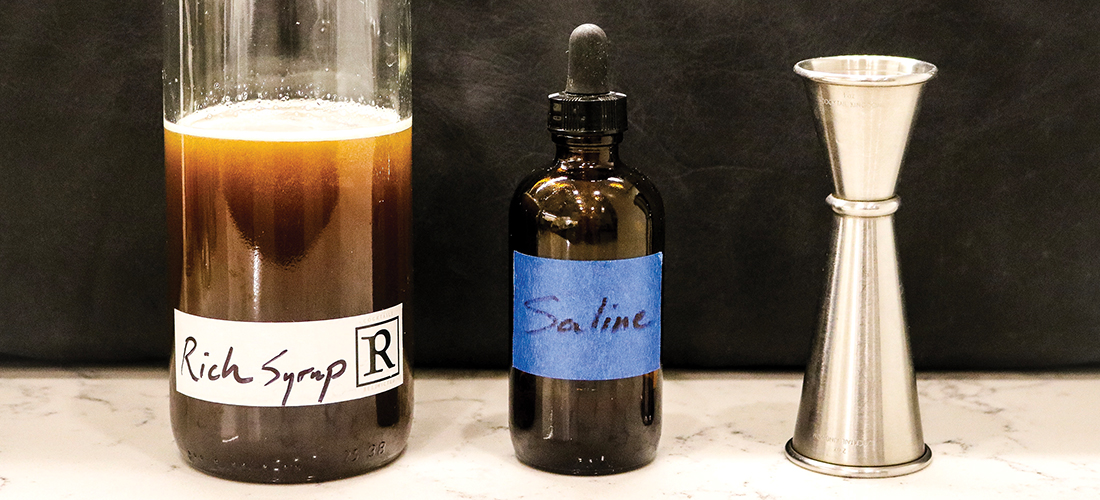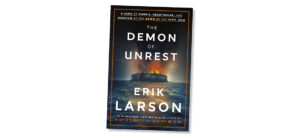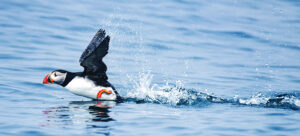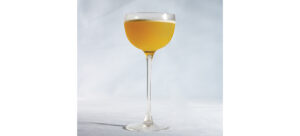
Syrup, Salt and Jigger
Keeping it simple and delicious
By Tony Cross
Last month I touched on a few drinks that can be made with only three ingredients. I’m carrying the theme over into October with three tips that can help improve your cocktail game. A lot of people have a fantastic collection of spirits and are super creative with their drinks. Others love trying new drinks, but when it comes to making them, would rather keep the ingredient list short and simple. Here’s something for both groups.
Your Simple Syrup
I don’t know how many times I’ve harped on this and I’m too lazy to check. Let’s just say this definitely isn’t my first rodeo when it comes to explaining why I think a 2-to-1 ratio with simple syrups is the way to go. When I first got into making everything from scratch behind the bar, simple syrup was first in line. Equal parts sugar and water. Easy enough. I’d take a measuring cup of baker’s sugar and then use the same cup to add water, throw them both in a pot over medium heat and stir the combo until the sugar disappeared. But then one night I saw a video clip of bartender Jaime Boudreau explaining how he makes a rich syrup for his cocktails. Rich syrup consists of two parts sugar and one part water. Boudreau explained that a richer syrup gives a cocktail more body. I’ll explain. If you’re using a 1:1 ratio, you have to use more of that syrup in each cocktail. Because the syrup is equal parts, and you’re using more, that means you’re adding more water to the drink as well. You’re over-diluting the cocktail. More so if you don’t weigh your sugar. If you use a measuring cup, it’s not going to be exactly one cup — it’s going to be under. In reality, your syrup ratio is 1-to-.80. I can’t stress the importance of weighing out the sugar (and water too). It’s going to make a huge difference in your next sour cocktail. Finally, please don’t think that having a richer syrup is going to mean your end product will be sweeter. If measured correctly (see below), you’ll have a more velvety feel on your palate from your perfectly balanced drink. Try this:
Whiskey Sour
2 ounces Rittenhouse Rye
3/4 ounce lemon juice
1/2 ounce rich simple syrup
Add ingredients in a shaker with ice. Shake hard until proper dilution has occurred. Strain into a rocks glass over ice. Garnish with oils from a lemon peel. Taste the difference.
Salt + Citrus = Damn!
I can’t remember when I first heard about adding salt to sour-style cocktails. I believe there was a cocktail competition out West, and the guy who won added saline to all of his drinks. It was definitely a duh! moment. Here’s the thing, though — you don’t have to just add them to shaken drinks. A small pinch of salt can go a long way in stirred drinks as well. Mess around with it to get the right balance. I’ve done a pinch of salt in drinks before. I’ve also made a saline solution. My preference? Saline. I like knowing that I’m going to get the same result when measuring out the drops. In the past when I’m busy, I know I’ve pinched a bit too much salt at times. So, what I’ll normally do now is make a solution of 3 parts salt to 1 part water. I’ve always used Himalayan pink salt, so I’d recommend starting there. I will say, I don’t think it’s necessary to use salt for every citrus cocktail, but it definitely helps, especially when your fresh pressed juice has been sitting for half a day. Lemon and lime juice start losing their pop in around five hours, so a dash of salt could bring it back to life. Another way it helps is with consistency. The juice from one case of lemons may differ in taste from the next. The same goes for limes and grapefruit.
Daiquiri
2 ounces Flor de Caña dry rum
3/4 ounce lime juice
1/2 ounce rich simple syrup
3 drops saline (3:1)
Combine all ingredients into a shaker with ice. Shake hard until your vessel is frosty cold. Double strain into a chilled cocktail coupe. No garnish.
Measure, Measure, Measure
This is another one that I’m sure I’ve beaten to death, but it’s so important — more so than the first two tips above. When I first got into bartending, I was obsessed with a bar in New York City that was one of the first bars in the new millennium’s surging cocktail trend. These guys made (and sold to other bars) their own syrups, bitters and cordials. Their drinks looked amazing, their uniforms were cool, and the bar itself was gorgeous. They did not measure. They eyed all of their cocktails. The risk factor in throwing a drink off balance made it even cooler in my eyes. So, that’s what I started doing. I would eye all of my drinks. I got decent at it, but do you know how hard it is to eye 1/8 an ounce for a cocktail when you’re slammed? It can be done . . . if you’re a bartending guru, which I was not and am not. I’m not sure why I got back into measuring. It was probably some David Wondrich article I read that stressed the importance of it. If so, he was right. Understatement. Consistency is key. I do remember that the month I got back on the jigger train, more compliments were directed at our waitstaff about the drinks. It means a lot when your guests return for another cocktail because they know it’s going to be just like it was the last 30-something times they imbibed there.
Put your pride aside and pick up a jigger. That is, unless you’re a guru. And if you are, please show me your ways. PS
Tony Cross is a bartender who runs cocktail catering company Reverie Cocktails in Southern Pines.





